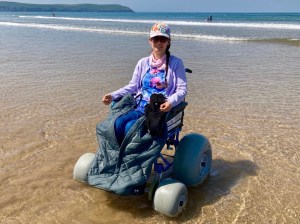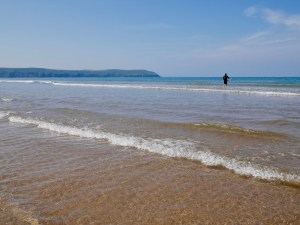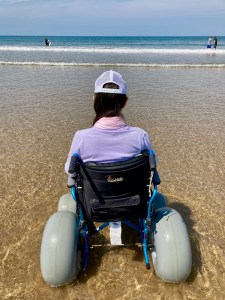
This summer I touched the sea for the first time in over thirty years. I sat on the shore and saw waves lap around my wheelchair. I felt the rush of sea air against my face and tasted salt on the breeze. It was magical.
For a long time, I believed I would never see the sea again. In the darkest days of my suffering, it was impossible to conceive of a time when my body might begin to heal. And when improvement eventually came, it was in increments so small that the outside world felt no closer. It seemed entirely possible that the time required for me to make significant progress might outrun the span of life available to me.
The world and I have changed greatly in the three long but fleeting decades of my illness. I have passed from childhood, through my teenage years and far into adulthood. In the time I have been ill, lengthy wars have been fought, rulers displaced, and new countries created. Babies have been born, grown to adulthood and started families of their own. I have been missing from the world for a span of time that is almost unfathomable.
On the day I saw the sea again in early summer, the sun was bright and hopeful, and the colours vivid. I made my way across the beach in a specially hired beach wheelchair.
In my diary I wrote:
“Seagulls swooped overhead, their feathers brilliant white against a deep blue sky. As we moved closer to the shoreline I could smell salt and seaweed. The sound of the sea grew louder with each step, while a strong breeze rushed out to greet me like an old friend.”
As always when outside, I was struck by the vastness of the world beyond walls.
“The sheer scale of everything was incredible. From where we were, the row of coloured huts at the top of the beach looked like a small string of beads. Turning to look along the shore, the other people looked tiny. The immensity of space was breathtaking.
“The waves were huge: great walls of water rising up and crashing down into thick bands of foamy white, before running in to shore as softer ripples.”

We kept walking until the wheels of my chair were in the water. I was in contact with the sea for the first time in thirty-two years.
“A wave splashed up against the chair and rippled, white and glinting, all around me. Sunlight turned the wave tips to shimmering crystal, while shadows danced across the shallow water. The sand beneath was ridged, and I remembered how it felt to walk on sand like that.”
Unsurprisingly, it was a moment of many emotions.
“Before me was the ocean in all its roaring energy. Its might and beauty were too much to contain, and tears filled my eyes. The experience of being there was both moving and exhilarating.”
On the one hand it was hard to process the magnitude of the moment, and all it represented in terms of both achievement and loss. On the other, it was so wonderful to be there in the sea, watching the waves race towards me, that the immediate moment left little room for anything else. The power and wonder of nature filled me.
There was a sense of freedom in the experience, but ever-present reminders of my limitations.
“The sensory demands were considerable, and after a while at the shore I could feel my brain struggling to keep up with the sights and sounds, and the constant motion of the waves. It was hard to tear myself away from the sea, and, having turned to leave, I several times went back.”
On the way back up the beach, I leant out of my chair and wrote my name in the sand with a spade. There was symbolism in the act: I was leaving my mark on a world that has often seemed to have forgotten my existence. I liked to think of strangers passing by and wondering who Naomi was. They could never have imagined the story that lay behind that name in the sand; the suffering and the courage that shaped those scratched letters.

“Some more memories: The fresh rush of sea air against my face when turned towards the ocean, and the warm embrace of the sun when facing back towards the beach. The loud roar of the surf, the softer lapping of the closer waves, and the fragmented cries of people enjoying the sunshine. The bright primary colours of the lifeguards’ red and yellow flag flapping against the blue sky. The shining white of seagulls bobbing in a row out on the sea.”
My sitting at the edge of the sea this summer could rightly be called a miracle. Yet at the same time there is something diminishing in the word and its implication of sudden and glorious resolution. In reality my time on the beach represented a small (but huge) victory in a long and painful struggle; one which is very much ongoing.
The greater part of my achievement lies not in the hour spent in sunshine at the sea shore, but in the years I lay trapped in literal and figurative darkness, unable to move or speak. It lies in the spirit that never gave up (though admittedly it came close) even when near death; even when repeatedly written off by professionals; and even when significant relief from suffering seemed impossible.
The achievement also owes much to a family who have never wavered in their support of me, and who invested an immeasurable amount of effort in getting me safely to the coast. In the midst of a pandemic, this included them being willing to completely isolate both before and during our time away.

Two years ago in Glimpsing the World: My Joy and Pain, I described the sunshine and shadow of rediscovering the world. After my trip to the beach this summer, my emotions again pulled in conflicting directions: there was a confusion of deep gratitude, overwhelming joy and aching grief. There was elation at what had happened, but with it, inevitably, came a new awareness of what I am missing.
“My heart longs to walk along the beach. To arrive there freely, without being any kind of an encumbrance to others. (They don’t view it that way, but I do.) To be unlimited, unrestricted, unchained. To be free on the beach in the way I was as a child.”
Very often, the most challenging part of an experience like this can be allowing both joy and grief to sit side by side. And to recognise that the immensity of my joy and appreciation is shaped by that very loss: ultimately the two are inseparable.

As I sat at the edge of the sea, I was struck by a deep feeling of familiarity. I’ve noticed before how the strength of certain memories creates a sense of timeless continuity. I had not experienced the sea close up since childhood: at the very most, as a child, I would have spent a few days out of twelve summers on the beach. Since then, there had been a hiatus of thirty-two years. And yet the memory of the sea was so vivid, the sights and sounds so evocative, that it was as though time on the beach formed the greater portion of my life; as though there had been little interruption in this connection with nature. I was at one with the sea, with the sky, with the air – and could easily have believed that it had always been so.
And in writing this now, it occurs to me that maybe it had. Maybe, even as I lay in unimaginable suffering, clinging on to myself and to life, I was always part of of the natural world in ways I couldn’t understand. I was part of its rhythms, its beauty and even its power. In reconnecting with the sea, I was not so much rediscovering an old experience, as recognising a connection that had never gone away.
“I soaked up the precious gift of blue and gold; of space and colour and infinity. I gave thanks for the chance to hope, and to know peace and beauty again.”
I have no idea when I will see the sea again. The effort is so enormous, the practicalities so complex, that there are no guarantees. But while I wait, and while I continue to live through both the difficulties and gradual gains of my daily life, I remind myself of this:
Somewhere deep inside, I hold the sea. It is forever part of me.

Image credits: All photographs copyright Naomi Whittingham
Image descriptions:
Main picture: Naomi sits at the edge of the sea in a beach wheelchair (which has special large wheels for the sand). She wears sunglasses and a multi-coloured cap, and is smiling at the camera. She is wearing a blue and pink top with a flower pattern, and a pale purple cardigan. Her jeans are partially covered by a wheelchair leg cover. It is a bright, sunny day.
Other images: 1) Foamy white waves coming in to shore. The sea and sky are blue. 2) A close-up shot of ‘Naomi’ written in the sand. 3) Small waves rippling at the edge of the sea. Sunlight sparkles on the water, which is clear. Sand can be seen beneath it. 4) The sea as seen from the shore, looking out towards the horizon and headland. The sea is clear and sparkling in the foreground, and blue further out. A surfer stands in the waves. 5) Naomi sits in a wheelchair at the edge of the sea. The camera is behind her. The sea and sky are blue
